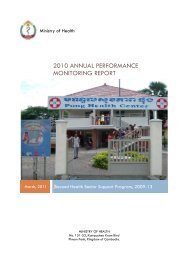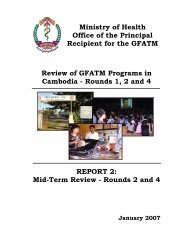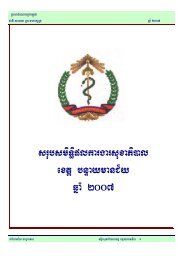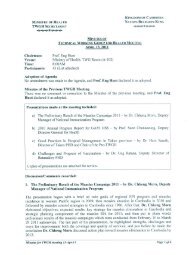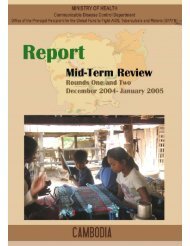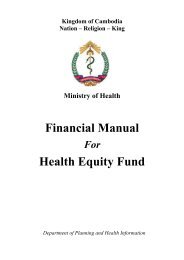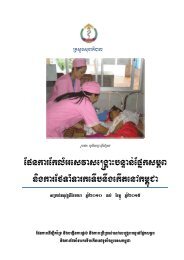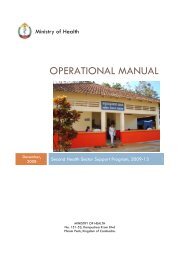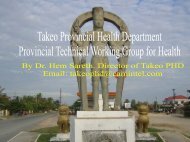Joint Annual Performance Review 2007 - Ministry of Health
Joint Annual Performance Review 2007 - Ministry of Health
Joint Annual Performance Review 2007 - Ministry of Health
You also want an ePaper? Increase the reach of your titles
YUMPU automatically turns print PDFs into web optimized ePapers that Google loves.
Based on the production capacity <strong>of</strong> the TSMC/RTCs and the availability <strong>of</strong> clinical sites, the<br />
number <strong>of</strong> new intakes for post basic midwifery will maintain to 80 per year for <strong>2007</strong> and<br />
2008.<br />
b. Production <strong>of</strong> Primary midwifery graduates<br />
The number <strong>of</strong> the first batch graduates <strong>of</strong> the primary nurse midwife implemented in the four<br />
RTCs graduates is 398. Among them, 192 are primary midwives. The intakes <strong>of</strong> the second<br />
batch for fiscal year 2006-<strong>2007</strong> are 246 in which 146 are primary midwife students. The<br />
selection based on the identification <strong>of</strong> vacant post suggested from relevant PHDs and<br />
choosing applicants leaving in the community near by the HC coverage. Based on the<br />
experience from the previous batches, the students with educational background <strong>of</strong> class 7,<br />
10, or 11 affect to the low quality <strong>of</strong> teaching and learning activity. It is recommended to<br />
review the selection criteria due to most applicants have high school diploma for the<br />
recruitment <strong>of</strong> new intakes this year. It is planned to recruit primary midwifery students 120<br />
for <strong>2007</strong> and same for 2008 with the proposed selection criteria at the 4 RTCs. Consideration<br />
should be made on the recruitment <strong>of</strong> intakes after 2008 based on the number <strong>of</strong> midwives<br />
new allocation to health facilities.<br />
c. Revitalization <strong>of</strong> the 3 year program <strong>of</strong> Midwifery pre service training<br />
Due to the recently implementation <strong>of</strong> the post basic midwife, the plan to revitalize <strong>of</strong> the<br />
three year midwifery program was suspended and it is recommended to wait for the finding <strong>of</strong><br />
Midwifery Mission Team as well as decision from Top MoH. Therefore, curriculum<br />
development should be started in <strong>2007</strong> and expected to be finalized it end <strong>of</strong> 2008.<br />
B. Provision <strong>of</strong> midwifery skills<br />
There are 84 HC staffs receiving the 4 month midwifery course. Among them 60 are funded<br />
by HSSP, 12 by RACHA, and 12 by BTC. RACHA also support 117 staff to the LSS course.<br />
The continuing education for HC staff is managed by the TSMC/RTCs with the collaboration<br />
from relevant PHDs. In the other hand, JICA support 40 midwives working at RHs for CPA<br />
midwifery course managed by the NMCHC. Same as in the previous year, it is expected to<br />
have 100 HC staff trained in midwifery skills (Midwifery 4 month course, NMCHC course,<br />
LSS course) every year for <strong>2007</strong> and 2008.<br />
1. Strengthen human resource planning to reduce mal distribution (Strategy 12)<br />
The two strategies related to equitable distribution <strong>of</strong> qualified staff to health facilities<br />
remain effective for HR management:<br />
• Identification <strong>of</strong> staff needed for each level <strong>of</strong> health service<br />
• Provision <strong>of</strong> appropriate skills and knowledge to staff for better service delivery<br />
a. Identification <strong>of</strong> staff needed for each level <strong>of</strong> health service<br />
The combination <strong>of</strong> Standard Staffing Level formula and the CPA Guidelines into the HR<br />
Database provide clear direction to the PHDs for staff needed at their organization. The<br />
promotion <strong>of</strong> using the HR database is very crucial to use it as mean for the purpose <strong>of</strong> staff<br />
management. The utilization <strong>of</strong> HR database is first started with the identification <strong>of</strong> vacant<br />
post for midwives. Therefore in reflection to the gap identified by the HR database and in<br />
consultation with both Departments and relevant PHDs, in 2006, 51 midwives have been<br />
recruited to the vacant posts against 100. Among them, 34 are Primary Midwives and 17 are<br />
Secondary Midwives <strong>of</strong> the post basic midwifery course. The expectation <strong>of</strong> at least 70% <strong>of</strong><br />
- 52 -



